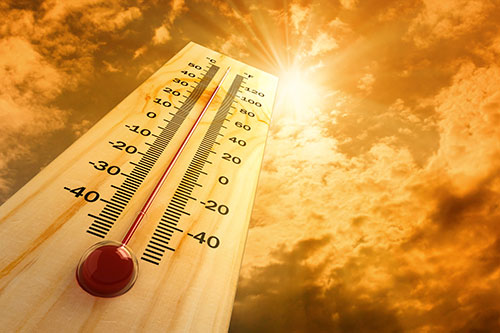
Beat The Heat: How To Keep Employees Safe When Temps Rise
Every year, thousands of workers become ill or injured as a result of heat exposure in their workplace, according to the Occupational Safety and Health Administration (OSHA). Workers who are primarily outside or in open-air workspaces during the summer months, such as gardeners, car wash employees and automotive technicians, have a higher risk of heat-related injuries. Indoor workers, such as line cooks, chefs and bakers, face these risks as well. Here are three important steps you can take to help keep your employees safe when temperatures climb.
- Understand the effects of extreme heat exposure. Excessive heat exposure is a severe health hazard that can be potentially fatal. It needs to be taken seriously. When external temperatures rise, the human body perspires in order to compensate and maintain a stable internal temperature. However, when air temperature is close to or exceeds normal body temperature (98.6 degrees Fahrenheit), cooling down becomes much more difficult. The body is unable to lose its heat through sweating and begins to store it. This causes the body’s core internal temperature to rise and the heart rate to increase. If the body is unable to cool down for a sustained period of time, a person can lose focus, become nauseous and, in extreme cases, lose consciousness.
- Prevent heat-related illness or injury. To help workers stay cool, provide easy access to fresh, cold water and make sure employees take regular hydration breaks. For outdoor workers, provide a water cooler located in a shaded area. In warm indoor environments, like kitchens, make sure fans and air conditioning units are available and operating properly. Warmer temperatures can tempt some workers to try to stay cooler by not wearing certain safety equipment, such as goggles, masks, gloves or other protective clothing. Even in hot summer months, make sure everyone wears the necessary safety equipment for their job.
- Know how to recognize and properly treat extreme heat exposure. When an employee is exhibiting symptoms of heat-related illness, it is important to respond quickly and appropriately. There are four common heat-related illnesses and each is treated differently. According to OSHA, these are the proper steps to take for each:
- Heat rash symptoms include clusters of red bumps, commonly on the neck, chest or in folds of skin. Keep the affected area dry and relocate the worker to a cooler or less humid environment.
- Heat cramps include muscle spasms and pain in the abdomen or limbs. Encourage the worker to rest in the shade or in a cool room, and make sure he or she drinks plenty of cold water. The worker should rest for several hours before returning to strenuous work or seek medical attention if the cramps do not subside.
- Heat exhaustion can cause headaches, nausea, vomiting or dizziness. The worker should immediately sit or lie down in a cool, shaded area, drink plenty of cool liquids and apply ice packs to his or her armpits to lower his or her core temperature. Seek emergency care if symptoms are not improved within an hour.
- Heat stroke is an emergency. The worker may exhibit confusion, fainting or seizures, accompanied by an extremely high body temperature. Call 911, and while waiting for help to arrive, loosen the employee’s clothing, apply cold packs to his or her armpits and encourage him or her to drink plenty of fluids.
When temperatures rise, so do the risks of heat-related illnesses. Knowing how to recognize the symptoms and deliver appropriate care to a worker suffering from heat-related exposure are important steps business owners can take to help keep their employees safe.
Sources:
1. Heat-related Illnesses and First Aid. United States Department of Labor Occupational Safety & Health Administration. https://www.osha.gov/SLTC/heatstress/heat_illnesses.html
